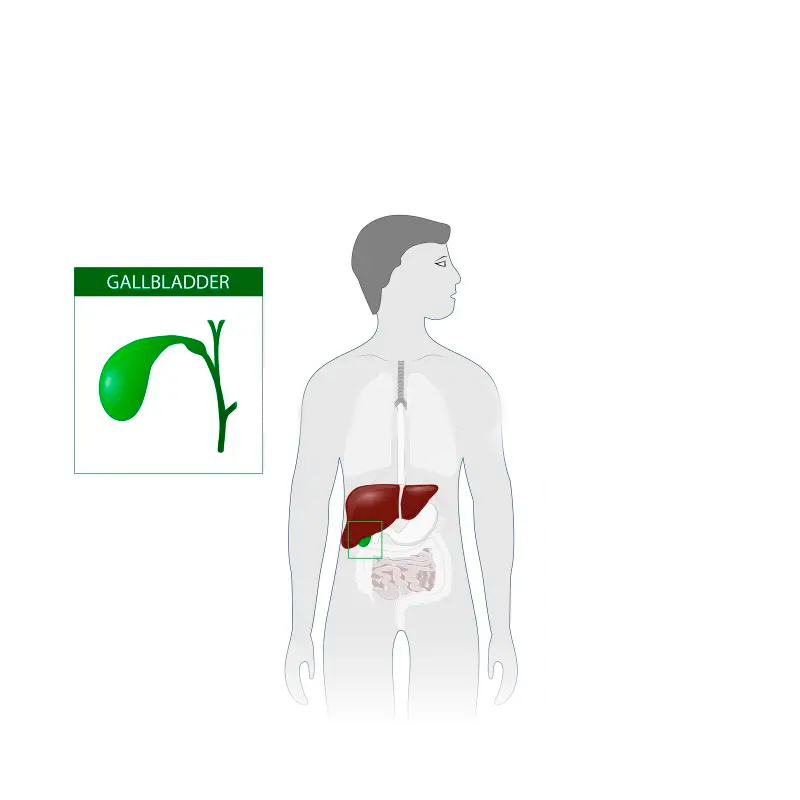Gallbladder Surgery and Gallstones
28 October 2025 –
![]() Ernesto Escobar, MD
Ernesto Escobar, MD
The gallbladder is a sac-shaped organ attached to the liver. Its function is to store bile produced by the liver, concentrate it, and release it into the duodenum (small intestine) to aid in the digestion of fats.
The most common gallbladder disease is the formation of stones (Cholelithiasis). These stones develop when the composition of bile is altered due to dietary factors, other diseases, or racial and genetic predispositions.
The presence of gallstones may occasionally be asymptomatic (produce no symptoms) or completely symptomatic, presenting with various types of discomfort.
Symptoms
Usually, when the gallbladder begins to cause problems, the typical clinical presentation is as follows:
-
Pain in the right upper quadrant of the abdomen that may radiate to the back or right shoulder. These symptoms usually appear after consuming fatty foods or dairy products.
-
If the pain is intermittent—meaning it comes and goes—this is referred to as biliary colic.
-
If the pain remains constant for six hours or more and is accompanied by other symptoms such as nausea, vomiting, and fever, then this is acute cholecystitis (inflammation of the gallbladder).
Complications
The risks associated with having gallstones include:
Pyocolecystitis/Empyema: accumulation of pus within the gallbladder.
Gangrene of the gallbladder and perforation with peritonitis.
Choledocholithiasis: migration of gallstones into the common bile duct (the ducts that carry bile from the liver) causing biliary obstruction. The obstruction manifests as elevated bilirubin levels, producing a yellowish discoloration (jaundice) of the conjunctiva and skin, often accompanied by dark yellow/amber-colored urine (choluria) and, in some cases, pale or white stools (acholia).
When biliary obstruction is accompanied by bacterial migration into the bloodstream, cholangitis develops. This is a serious condition that can lead to complications such as hepatic abscesses, acute renal failure, sepsis, and death.
Migration of gallstones can also block the pancreatic duct and cause biliary pancreatitis, which may be life-threatening or require extensive surgical procedures to remove necrotic infected pancreatic tissue.

Other Conditions
Other disorders can cause gallbladder symptoms without the presence of stones. For example, biliary dyskinesia, which is a dysfunction in gallbladder contraction causing distention and symptoms similar to those of gallstone obstruction.
Less common, but with devastating consequences, is gallbladder cancer, which—if detected early—can be successfully treated with radical surgery.
Treatment
Laparoscopic Surgery
The treatment for gallbladder diseases is Laparoscopic Surgery (minimally invasive procedure using small incisions and a video camera).
The surgery involves making a 1 cm incision through the navel to insert the video camera, followed by three additional small incisions in the upper abdomen to perform the resection/removal/excision of the gallbladder. In this procedure, the gallbladder is removed along with the stones.
Open Surgery
raditional or open surgery is performed through an incision longer than 15 cm, usually below the rib margin or along the midline of the abdomen. This approach is becoming less common and is reserved for special cases such as:
Multiple previous surgeries that contraindicate laparoscopy.
Anticipated need for radical resection due to cancer that cannot be performed laparoscopically.
Anticipation of more complex procedures during surgery (bile duct exploration, biliodigestive bypass, sphincteroplasty).
Lack of laparoscopic training.

Dr. Ernesto Escobar performing Laparoscopic Surgery
Laparoscopic (minimally invasive) surgery allows for less postoperative pain, faster recovery, and shorter work disability time.
